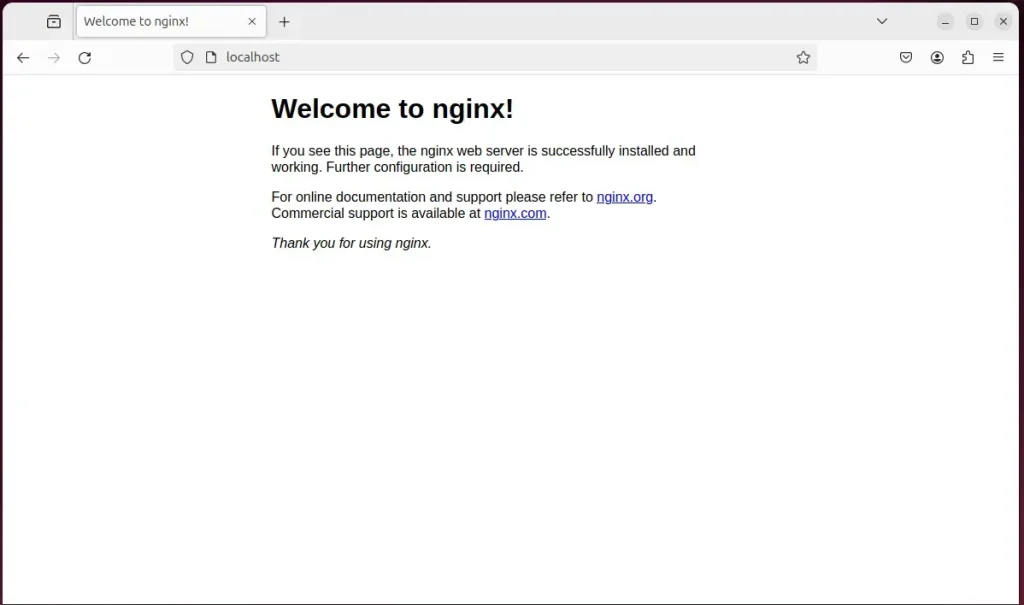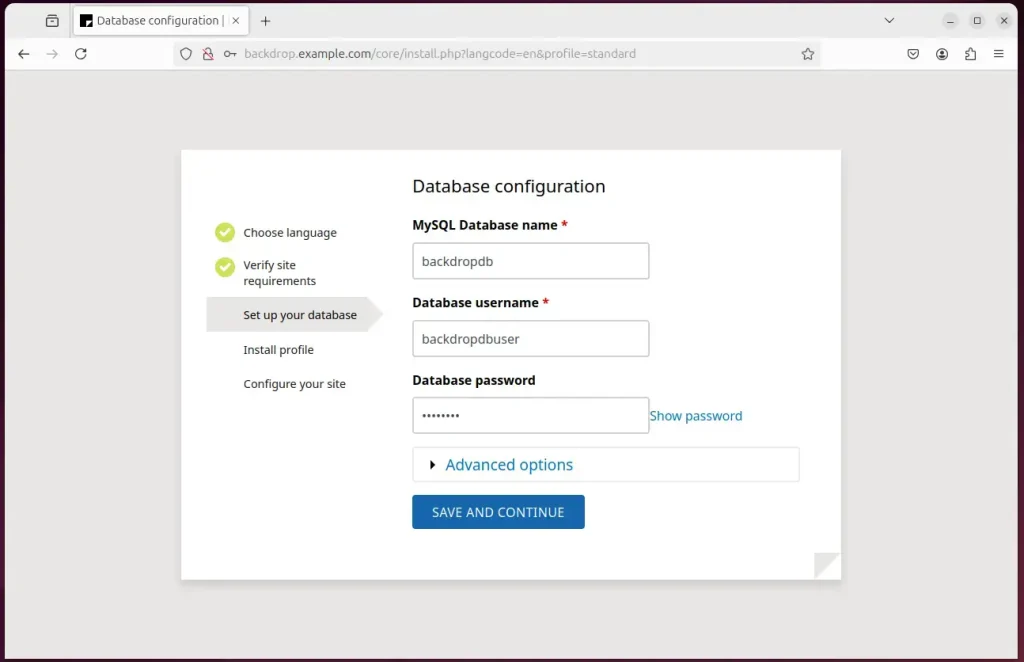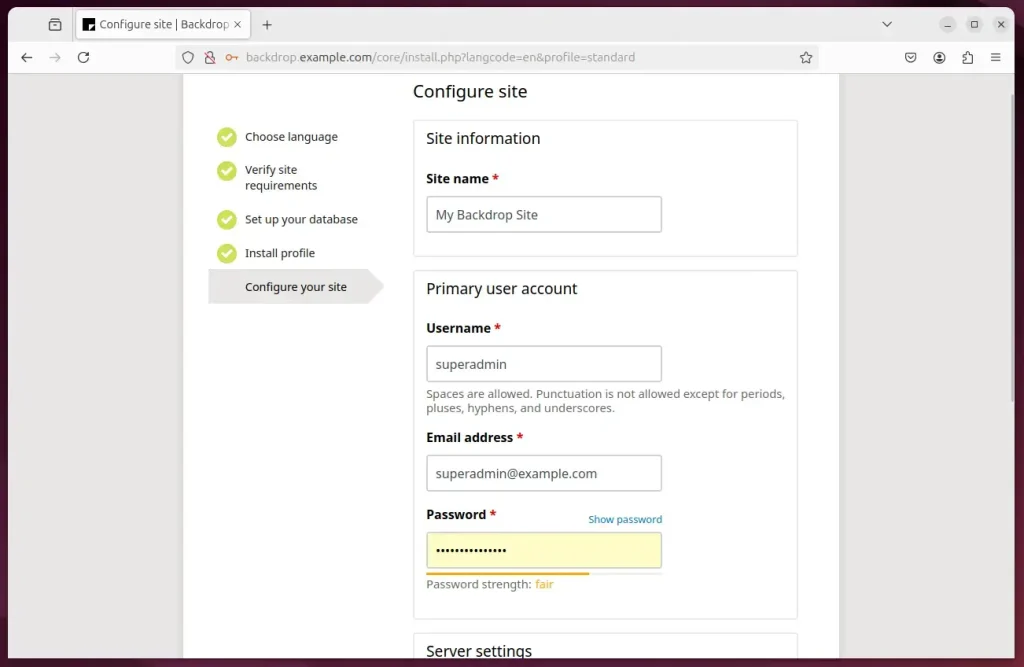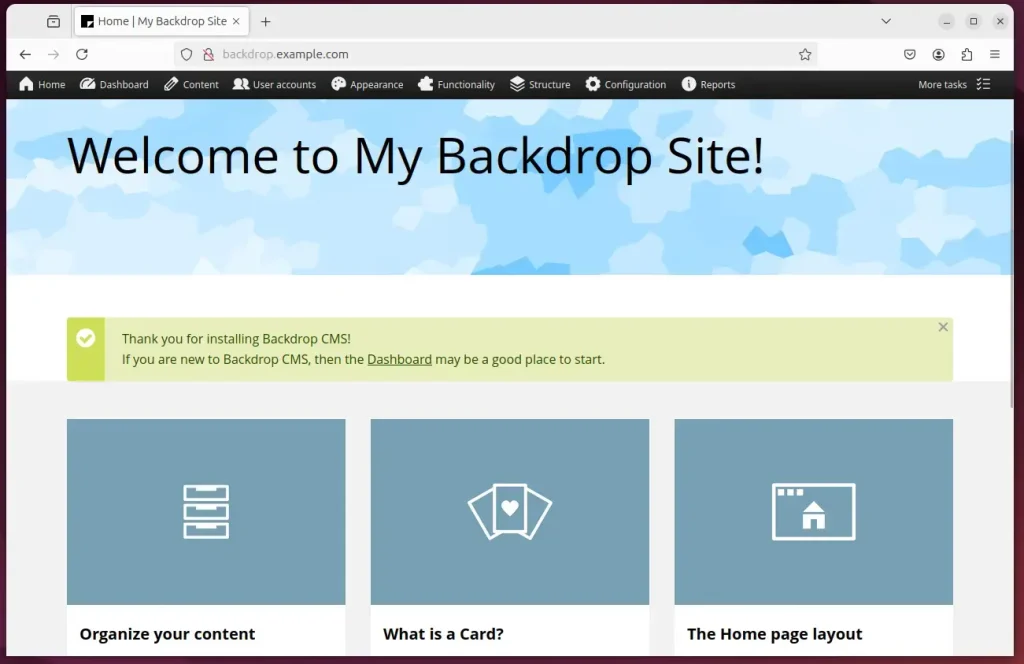This article explains installing Backdrop CMS with Nginx on Ubuntu 24.04.
Backdrop CMS is a fork of Drupal, allowing users to easily create content without coding knowledge or experience with PHP-based applications.
Nginx is the second most popular web server required for Backdrop to function. Finally, Ubuntu Linux is a popular operating system choice for web servers due to its security, stability, and ease of use.
By setting up Backdrop CMS with Nginx on Ubuntu Linux, users can create and publish content quickly and efficiently while ensuring their website is secure and stable.
Install Nginx HTTP server on Ubuntu
Backdrop requires a web server. This post will install and use the Nginx web server to run Backdrop.
To do that, open the Ubuntu terminal and run the commands below to install the Nginx web server.
sudo apt update
sudo apt install nginx
Once Nginx is installed, the commands below can start, stop, and enable the Nginx web server to start automatically when your server boots up.
sudo systemctl stop nginx
sudo systemctl start nginx
sudo systemctl enable nginx
You can test the Nginx web server by opening your web browser and browsing to the server’s localhost or IP address.
http://localhost

When you see the Welcome to nginx!, it means the Nginx HTTP server is successfully installed.
Additional help on installing Nginx on Ubuntu is in the link below.
How to install Nginx on Ubuntu
Install the MariaDB database server on Ubuntu
The next component required to run Backdrop is a database server. This post will install and use the MariaDB database server.
To install and use the MariaDB database server, use the instructions below.
Open the Ubuntu terminal and run the commands below to install the MariaDB database server.
sudo apt update sudo apt install mariadb-server
Once the MariaDB database server is installed, use the commands below to stop, start, and enable the MariaDB server to start automatically when the server boots.
sudo systemctl stop mariadb sudo systemctl start mariadb sudo systemctl enable mariadb
Run the following commands to validate and test if the MariaDB database server is installed successfully.
sudo mariadb
Once you run the commands above, it will log you onto the MariaDB console and display a message similar to the one below.
Welcome to the MariaDB monitor. Commands end with ; or g. Your MariaDB connection id is 32 Server version: 10.11.2-MariaDB-1 Ubuntu 23.04 Copyright (c) 2000, 2018, Oracle, MariaDB Corporation Ab and others. Type 'help;' or 'h' for help. Type 'c' to clear the current input statement. MariaDB [(none)]>
The message tells you that the server is installed successfully.
Additional help on installing MariaDB.
Create a Backdrop database
Upon successfully installing the MariaDB database server, create a blank database on the server specifically for the Backdrop application.
As part of the setup, we will create a backdropdb database and a user account called backdropdbuser.
Finally, we’ll grant the backdropdbuser full access to the backdropdb database.
All the database steps above can be done using the commands below:
But first, log on to the MariaDB database server:
sudo mariadb
Then run the commands below to complete the steps:
CREATE DATABASE backdropdb CHARACTER SET utf8mb4 COLLATE utf8mb4_general_ci;
CREATE USER backdropdbuser@localhost IDENTIFIED BY 'type_your_password_here';
GRANT ALL ON backdropdb.* TO backdropdbuser@localhost WITH GRANT OPTION;
FLUSH PRIVILEGES;
exit
Ensure to replace ‘type_your_password_here ‘with your password.
Install PHP on Ubuntu Linux
The last component you will need to run Backdrop is PHP. The Backdrop application is PHP-based and supports the latest versions of PHP.
Then, run the commands below to install the latest PHP version.
sudo apt install php-fpm php-intl php-mysql php-curl php-cli php-zip php-xml php-gd php-common php-mbstring php-xmlrpc php-bcmath php-json php-sqlite3 php-soap php-zip
Additional help on installing PHP
How to install PHP on Ubuntu Linux
Download Backdrop files
Let’s begin downloading and configuring the Backdrop files on Ubuntu Linux.
To always install the latest version, check the download page for Backdrop. Get the download link and download the archived package to your computer. Then, extract it.
First, navigate to the /tmp/ directory and download the Backdrop files. Next, move the content into the Backdrop folder in the Nginx root directory.
The final step is to change the permissions. This will allow the Nginx web server to interact safely with the files, ensuring a secure environment for your Backdrop installation.
cd /tmp/
wget https://github.com/backdrop/backdrop/releases/download/1.29.1/backdrop.zip
sudo unzip backdrop.zip
sudo mv backdrop /var/www/backdrop
sudo chown -R www-data:www-data /var/www/backdrop
Once you have completed all the above steps, continue configuring the Nginx web server below to serve the Backdrop content.
Run the commands below to create a Nginx virtual host file for Backdrop.
sudo nano /etc/nginx/sites-available/backdrop.conf
Then, copy and paste the content block below into the Nginx server block.
server {
listen 80;
listen [::]:80;
root /var/www/backdrop;
index index.php;
server_name backdrop.example.com;
access_log /var/log/nginx/example.com.access.log;
error_log /var/log/nginx/example.com.error.log;
location / {
try_files $uri @backdrop;
}
location @backdrop {
rewrite ^(.*)$ /index.php?q=$1 last;
}
location ~ \.php$ {
include snippets/fastcgi-php.conf;
fastcgi_pass unix:/var/run/php/php8.3-fpm.sock;
fastcgi_param SCRIPT_FILENAME $document_root$fastcgi_script_name;
include fastcgi_params;
}
}
Save the file.
Then, run the commands below to enable the virtual host and restart the Nginx server.
sudo ln -s /etc/nginx/sites-available/backdrop.conf /etc/nginx/sites-enabled/
sudo systemctl restart nginx
Setup Let’s Encrypt SSL/TLS for Backdrop
You may want to install an SSL/TLS certificate to secure your Backdrop site. Secure your Backdrop installation with HTTPS from Let’s Encrypt.
Please read the post below for additional resources on installing and creating Let’s Encrypt SSL certificates for Nginx.
How to set up Let’s Encrypt SSL certificate for Nginx on Ubuntu Linux
Once you have restarted the Nginx web server, open your browser and browse to the server hostname or IP address defined in the Nginx server block.
http://backdrop.example.com
A Backdrop installation wizard page should appear. Select the installation language and continue.

Type the database connection details created above and continue.

Create an admin account and continue.

Your Backdrop site should be ready.

That should do it!
Conclusion:
Installing Backdrop CMS with Nginx on Ubuntu is a straightforward process that empowers users to manage their web content efficiently. Here are the key takeaways:
- System Setup: Installing Nginx and MariaDB lays the foundation for a robust web server environment.
- Database Configuration: Creating a dedicated database for Backdrop ensures a clean and organized data storage solution.
- PHP Installation: Utilizing the latest PHP version enhances application performance and security.
- File Management: Proper downloading and extraction of Backdrop files is crucial for seamless operation.
- Nginx Configuration: Setting up a virtual host enables effective handling of user requests for the Backdrop application.
- Security: Implementing an SSL certificate further protects user data and enhances trustworthiness.
- User-Friendly: The Backdrop installation wizard simplifies the final setup steps for a new site.
Users can create a secure and efficient website tailored to their content management needs by following these steps.

Leave a Reply